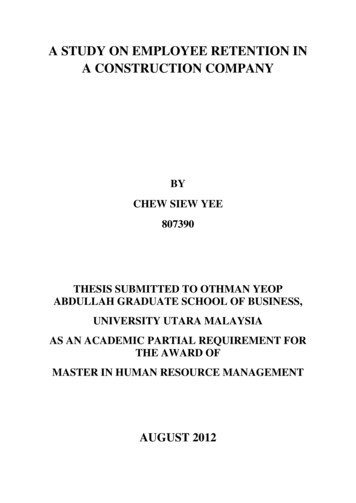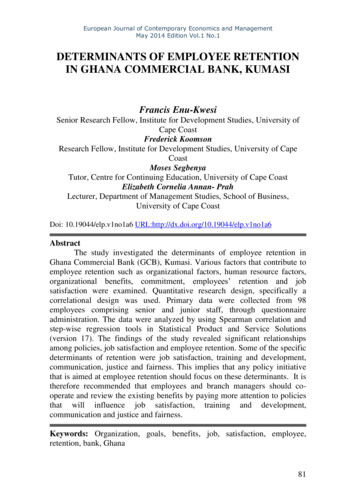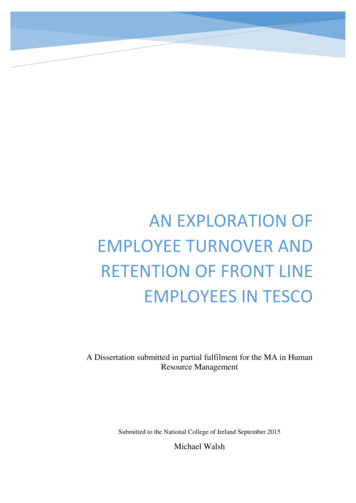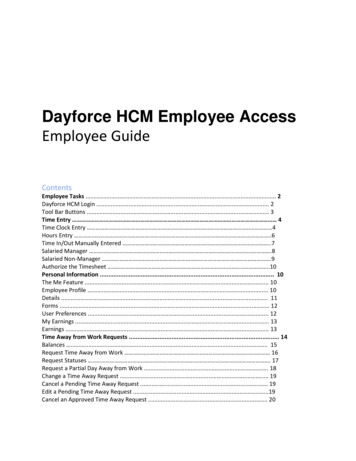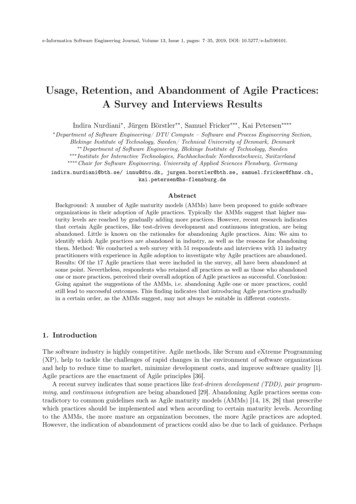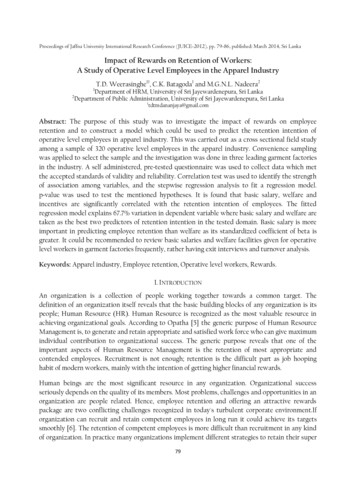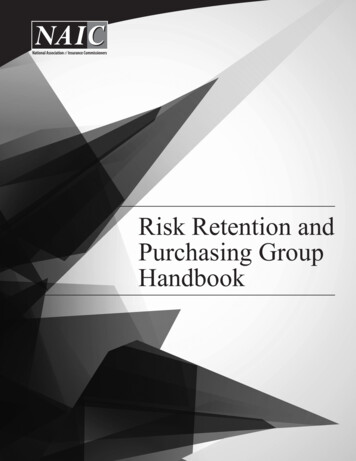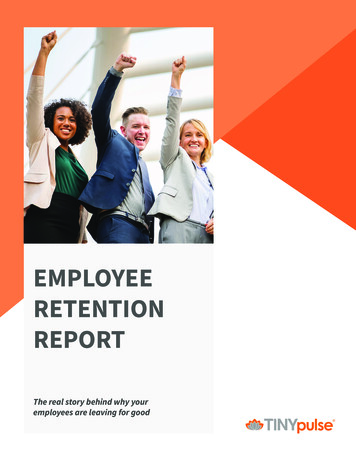
Transcription
EMPLOYEERETENTIONREPORTThe real story behind why youremployees are leaving for good#2018 ANNUAL RETENTION REPORT
TABLE OF CONTENTS#Introduction03Great Managers Fuel Employee Loyalty05Recognition Is a Matter of Priority07Culture Eats Compensation For Breakfast09Employees Crave Work-Life Balance11Growth Opportunities Are Talent-Magnets12Launching a Successful Employee Retention Strategy14About TINYpulse162018 ANNUAL RETENTION REPORT
32018 EMPLOYEE RETENTION REPORT INTRODUCTIONINTRODUCTIONTHE WAR FOR TALENT ISGROWING FIERCER BYTHE DAY.The U.S economy saw a steady rise in 2018, withunemployment dropping to just 3.7 percent— thelowest it’s been since 1969. In today’s job market,power lies in the hands of employees and leadersmust work harder than ever to retain their workforce.The purpose of this reportA study by Employee Benefits News states that theaverage cost of losing an employee is a staggering33% of their annual salary. When recruitment fees,training and lost productivity are taken into account,a high turnover rate can have crippling financialimplications for a business.We’ve created this report to help organizations tacklethe issue by empowering leaders to address the mostcommon drivers of attrition. The report builds on ourpopular past research and contains new findings,completely updated for 2018.Who this report will benefitThis report is essential reading for professionalsinvolved in people management and operationssuch as C-level executives, HR departments andmiddle managers. Employee engagement specialists,company culture enthusiasts and anyone committedto creating a better employee experience will alsobenefit from the findings presented here.What you will learn»» The top five factors that correlate to employeeturnover and fascinating statistics collectedacross hundreds of organizations that use theTINYpulse platform.»» Actionable advice from leadership experts thatany organization can follow to combat turnoverproblems or augment current growth.»» Our five-step approach to creating an effectiveemployee retention strategy. We’ll reveal howyou can identify the top attrition drivers in yourown workforce and launch an effective plan ofaction.A summary of our key findingsTo uncover what factors matter most to employeeswhen deciding to leave, we analyzed survey resultsfrom over 25,000 employees across the world fromJanuary to October 2018. Our research uncoveredfive key takeaways:1. Great managers fuel employee loyaltyWe found a direct correlation between howemployees feel about their supervisors andhow likely they are to look for employmentelsewhere. 40% of employees that do not ratetheir supervisor’s performance highly haveEmployees who rate theirsupervisor’s performance poorly are4x as likely to be job huntinginterviewed for a new job in the last threemonths, compared to just 10% for those that dorate their supervisor highly.
42018 EMPLOYEE RETENTION REPORT INTRODUCTION2. Recognition is a matter of priorityThe data speaks for itself: employees who feelunder-appreciated are unlikely to stay withtheir employers. According to our data, 21.5% ofemployees that don’t feel recognized when theydo great work have interviewed for a job in thelast three months, compared to just 12.4% thatdo feel recognized.3. Employees crave work-life balanceEven the highest paid employees in the world stillleave their jobs when the risk of burnout looms.A salary raise may work effectively as a bandaid, but before long, overworked employeeswill likely start reviewing their exit strategyEmployees with a good work-lifebalance are 10% more likely to stayat their companiesonce again. Employees who rate their work-lifebalance highly are 10% more likely to stay at theircompany.4. Culture eats compensation for breakfastFor today’s workforce, a job is more than just apaycheck - employees want to grow meaningfulrelationships in a great cultural environment. Infact, our research shows that the way employeesview their company culture has an even biggerimpact on turnover than how they view theirbenefits package.5. Growth opportunities are talent-magnetsCompanies that support their employees in theirprofessional development are less likely to haveproblems with turnover. Our findings reveal thatemployees who feel they are progressing in theircareer are 20% more likely to still be working attheir companies in one year’s time.Employees who don’t feel supportedin their professional goals are 3x morelikely to be looking for a new jobThe results are clear: the intangible matters.Engagement, culture, and personal growth aren’t justbuzzwords. In our current economic climate, leadersand HR must address these factors if they want togrow a strong and loyal team.Combating turnover requires time and resources.But with the right strategic approach, leaders cansucceed in creating a happier, more productive workenvironment in a cost-effective way.Read on to learn how your organization can startbuilding the ultimate employee retention gameplan.
52018 EMPLOYEE RETENTION REPORT GREAT MANAGERS FUEL EMPLOYEE LOYALTYGREAT MANAGERS FUELEMPLOYEE LOYALTYSUPERVISOR PERFORMANCE ISCRITICAL TO THE SUCCESS OF ARETENTION STRATEGYEmployee-manager relationships play a fundamentalrole in retention. In fact, many of the other key driversof attrition identified in this report fall under thewheelhouse of middle-management. That’s why it’simportant to invest early in management training andprovide continuous support to help leaders grow theirpeople skills - an area that’s sorely neglected at manycompanies.Good managers are able to effectively communicatethe job duties involved in a role - a vital skill forkeeping employees focussed and goal-oriented.But our research found that role definition isn’t justimportant for productivity - it’s also important forretention. According to our data, employees are 23%more likely to stay if their manager clearly explainstheir roles and responsibilities.Employeeswith clearresponsibilitiesare 23% morelikely to stayIssues surrounding role definition are likely part ofa wider communication problem. In fact, a fear ofcommunicating with leadership is another driverof attrition. Employees that don’t feel comfortablegiving upward feedback are 16% less likely to stay attheir companies.Employeesthat don’t feelcomfortablegiving upwardfeedback are16% less likelyto stayIn addition, how employees perceive theirmanager’s overall ability is among the bestindicators of their intentions to stay or leave thecompany.Employees whopoorly ratetheir manager’sperformance are4x more likely tobe interviewingelsewhere
62018 EMPLOYEE RETENTION REPORT GREAT MANAGERS FUEL EMPLOYEE LOYALTYWe found that 40% of employees who do not rate theirsupervisor’s performance highly have interviewed for anew job in the last three months, compared to just 10%for those that do rate their supervisor highly.Key takeaways:»»»»»»Managers must be held accountable for turnoverwithin their teams. Performance evaluation at amanagerial level should go beyond the ability tohit key business metrics, and also take into accountfeedback from team members.Clear role definition is a key requirement foremployee engagement. Employees that feel a lackof direction from their managers are more likely toleave their companies.Leaders should train managers to welcome openand honest communication. Soliciting and actingon feedback from employees will help improveloyalty towards managers, and by extension theorganization.LEADERSHIP TIP FROM AN EMPLOYEEADVOCATE:Hiring and training for emotional intelligenceHeather Younger is an employee engagementexpert who has analyzed responses fromthousands of employee surveys at differentorganizations. In her best-selling book, TheSeven Intuitive Laws of Employee Loyalty,Younger cites ‘great managers’ as the numberone reason people stay at their organizations.The best managers, Younger argues, are thosewith strong emotional intelligence. “Ninetypercent of employee experience is driven byemotions. And leaders get to choose whichemotions they unleash within the people theylead.”Before leaders can foster employee loyaltytowards their companies, they first need tocultivate loyalty towards their managers.This means hiring and training for empathyand communication skills, rather than simplytechnical ability.Heather YoungerFounder & CEOCustomer Fanatix#
72018 EMPLOYEE RETENTION REPORT RECOGNITION IS A MATTER OF PRIORITYRECOGNITION IS A MATTEROF PRIORITYFREQUENT, INFORMAL RECOGNITIONIS A HIGHLY EFFECTIVE TOOL FORRETAINING HIGH PERFORMERSThe effectiveness of recognition efforts overall whenemployees do great work has a similar correlation:employees who are inadequately recognized for highperformance are almost twice as likely to be lookingfor jobs elsewhere.Employeeswho are notrecognized forgreat work are2x more likely tobe job huntingMost workplaces include some type of formalrecognition in their company cultures. Examplesinclude end-of-year bonuses tied to performance, ora ‘years of service award’ to recognize tenure. Whilethese more significant forms of recognition all havetheir place, it’s vitally important for managers to offersmall bursts of appreciation on a day-to-day basis.Employeeswho have notreceived recentrecognition are2x more likely tobe job huntingOur research found a correlation between frequentrecognition from a supervisor and employeeretention. We discovered that 24% of employeeswho felt they had not received recognition from theirdirect supervisor in the past two weeks had recentlyinterviewed for another position, compared to just13% who had received recognition.Recognition is important because it helps validatethe time and effort we expend at work. Employeeswant to know that their roles are meaningful andimpact the success of the business, and critically, thattheir team members acknowledge this too.When employers fail to provide evidence thatthey value their employees’ contributions, theirorganizations are more likely to experience turnover.Our research supports this: employees who do notfeel valued at work are 34% more likely to leave theircompanies within the next year.Employeeswho do not feelvalued at workare 34% morelikely to leave
82018 EMPLOYEE RETENTION REPORT RECOGNITION IS A MATTER OF PRIORITYKey takeaways:»»»»»»Recognition can come from any level of theorganization: workplaces that enjoy highretention rates incorporate upward, peer-topeer and cross-functional recognition into theircommunication streams.Managers should provide frequent, informalrecognition to their employees. Even a quickwritten gesture of appreciation, when dispensedon a regular basis can have a big impact onemployee retention.Feeling valued is a fundamental driverfor employee retention. Employers mustdemonstrate that they care about theiremployees and their work is important if theywant to retain their workforce.CASE STUDY:HOW COLLEGEWISE ACHIEVED A 0%TURNOVER RATECollegeWise is a college admission andapplication counselling service that has enjoyeda near 0% turnover rate over the last four years.CEO, Kevin McMullin says this is the result ofthe company’s commitment to humanizing theemployee experience and showing they care forpeople as individuals. Kevin shared with us howhe puts this commitment into practice:»»Important milestones at CollegeWise arecarefully orchestrated to make employeesfeel valued. For example, employeesare given personalized gifts and a warmwelcome by the entire leadership teamon their first day of work. For Kevin, greatemployee experiences hinge on keymoments like this.»»Rather than rewarding employees basedon tenure, CollegeWise tailors recognitionto achievements that are meaningful toemployees. For example, employees aregiven a plaque after serving 100 customers,with each customer’s name engraved on it.This approach also motivates less tenuredemployees to achieve the same milestone.»»The leadership team is encouraged totreat employees how they would wantloved-ones to be treated when placed in asimilar situation. Managers are emotionallyinvested, empathetic, and prioritize howthey want employees to feel.Kevin McMullinCEOCollegeWise
92018 EMPLOYEE RETENTION REPORT CULTURE EATS COMPENSATION FOR BREAKFASTCULTURE EATS COMPENSATIONFOR BREAKFASTCULTURE IS A TOP PRIORITY FOREMPLOYEES LOOKING FOR NEWOPPORTUNITIESEmployees whohighly rate theirMost employees will agree that company cultureplays a large role in deciding where to apply forjobs. Talented people naturally gravitate towardsenvironments that allow them to achieve their bestwork and successful organizations today are investingheavily to meet their needs.Conversely, organizations that provide ill-fittingcultures for their workers can expect to see higherturnover: employees who rate their culture poorly are24% more likely to leave their organizations within ayear’s time.Employees whorate their culturepoorly are 24%benefits packageare only 11% morelikely to stayOne of the most important building blocks for asuccessful culture is the company mission. A clearmission unites coworkers around a shared cause andhelps foster a bigger emotional investment in theirwork.This sense of purpose has a sizable impact on onemployee retention: employees who believe theircompany has a higher purpose than just profits are27% more likely to stay at their companies in the nearfuture.more likely to leaveEmployees whoIt’s clear that developing a great culture is a vitalpart of fighting attrition. In fact, we found this aspectof their work has an even bigger impact on anemployee’s decision to stay or go than their benefitspackage. While benefits are still important, leadersmust understand how to compete in the culturalarena and use culture as a point of differentiation ifthey are to attract and retain the best people.believe theircompany has ahigher purpose are27% more likelyto stay
102018 EMPLOYEE RETENTION REPORT CULTURE EATS COMPENSATION FOR BREAKFASTEmployees who feel their jobs are about more thanmaking money for the
201 EMPLOYEE RETENTION REPORT 5 GREAT MANAGERS FUEL EMPLOYEE LOYALTY SUPERVISOR PERFORMANCE IS CRITICAL TO THE SUCCESS OF A RETENTION STRATEGY Employee-manager relationships play a fundamental role in retention. In fact, many of the other key drivers of attrition identified in this report fall under the wheelhouse of middle-management. That’s why

